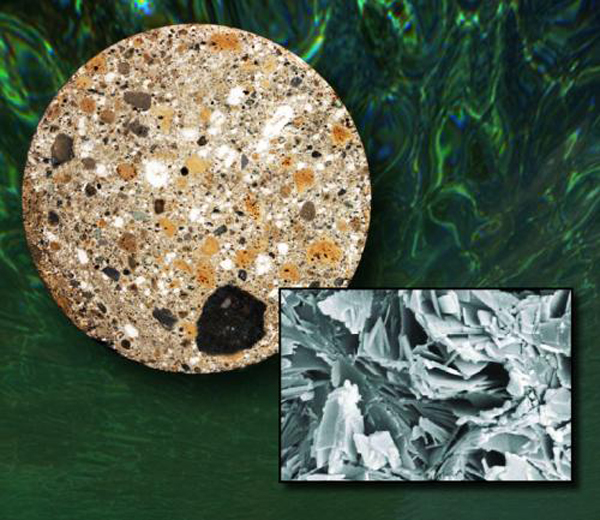
This discovery shows how to make stronger, longer lasting concrete with far less energy. A green type of concrete like this could replace Portland concrete, which is viewed negatively by many due to its adverse environmental impact.
“The chemical secrets of a concrete Roman breakwater that has spent the last 2,000 years submerged in the Mediterranean Sea have been uncovered by an international team of researchers led by Paulo Monteiro of the U.S. Department of Energy’s Lawrence Berkeley National Laboratory (Berkeley Lab), a professor of civil and environmental engineering at the University of California, Berkeley.
Analysis of samples provided by team member Marie Jackson pinpointed why the best Roman concrete was superior to most modern concrete in durability, why its manufacture was less environmentally damaging – and how these improvements could be adopted in the modern world.
The Romans made concrete by mixing lime and volcanic rock. For underwater structures, lime and volcanic ash were mixed to form mortar, and this mortar and volcanic tuff were packed into wooden forms. The seawater instantly triggered a hot chemical reaction. The lime was hydrated – incorporating water molecules into its structure – and reacted with the ash to cement the whole mixture together.”
Read more at the source: Phys.org

If in an earthquake area using rebar is suppose to be the way to build. I’m wondering if you use the plastic covered rebar when you bend it, does it leave hairline and very obvious breaks in it? I’d like to think my home will last many, many years. Where would someone find this volcanic “dust” to make this mix? It is dust isn’t it? Hawaii could be the next Rome if that’s the case. I’m amazed that it’s taken this long to find this out about their mix. But, just like oil companies and politicians the concrete makers probably have known all along.
Look for galvanized rebar if you live in an area where greater durability is needed. Areas with strong freeze/thaw cycles are among the hardest hit. You can get maps of freeze/thaw areas. You can also add air entrainment additives to the mix to help avoid freeze/thaw problems in concrete.
Look up pozzolans. There are different types. Some comes from volcanoes. (No reason to get it from Hawaii — it’s widely available.) Fly ash from coal plants is increasingly common. Many batch cement plants have fly ash, air entrainment chemicals and other additives that can be added to the concrete mix.
Roman concrete has been studied for a long time. This new study adds scientific details that seems to provide enough information to overcome any final barriers to commercializing it. But like I said, don’t expect cement factories to rush out and spend billions of dollars to change their factories right away.
Thanks Doc. No, I wouldn’t go that far with Hawaii Haha but, it would make sense if they used it there. That’s good to know about the freeze/thaw maps. I wasn’t aware of such a thing. I’ll check about pozzolans. That’s a new word for me. Again, “Thanks” for your direction.
Portland concrete falls apart in about 50-100 years, sometimes much sooner in harsh climates or if made incorrectly. Imagine 2,000 year old plaster on buildings, 2,000 year old foundations, etc. Suddenly concrete would have a much better reputation.
But don’t hold your breath. It could take 10-20 years to get this into the marketplace. Factories have to be modified. Engineers have to learn different methods. Codes have to be changed…
It is worthwhile to consider the most common reasons that concrete fails today.
As mentioned, making it incorrectly is a prime reason, but incorrect construction techniques can also play a huge factor.
As with almost every building material, natural or manmade, water is the enemy. Allowing water to wick into foundations followed by freeze/thaw cycles causes heaving and cracking. Water wicking through concrete tends to rust steel reinforcement inside the concrete. Rusting steel tends to expand as it rusts, causing stress in the concrete surrounding it, eventually cracking and breaking.
The more steel is used in concrete, the more important it becomes to keep the concrete dry if one wants it to last for hundreds of years. Rusting steel inside concrete is a slow process that won’t be noticed outside the concrete for a couple of decades, so most people tend to ignore it. This is one important factor not mentioned in the linked article. The Romans did not use reinforcing steel in their undersea concrete. Since there was no steel to rust and expand, the concrete has lasted much longer.
That is not to say that reinforcing steel is a bad thing. It simply must be used appropriately and protected if one wants it to last for more than a few decades.
Basic common sense building practices apply. They have been mentioned on this blog repeatedly. Build on high ground. Keep building materials dry. Use good roof overhangs. Maintain roof materials and siding materials. Grade the final landscape surrounding the structure to keep water away from the building.
Ferrocement structures are particularly vulnerable to water wicking into it, rusting steel mesh and framework, expansion, and fracture. To last, ferrocement needs to be protected and maintained to prevent water from wicking into the cement.
That’s right. Water is the #1 enemy of buildings. Wide roof overhangs are highly recommended.
Gravel bag (earthbag) foundations don’t have steel reinforcing as a general rule, and so that’s one way to avoid foundation problems. This assumes you’re building in a non-code area, of course. Use scoria or pumice in the gravel bags and you’ll have a superinsulated foundation at a fraction of the cost and labor of concrete foundations.